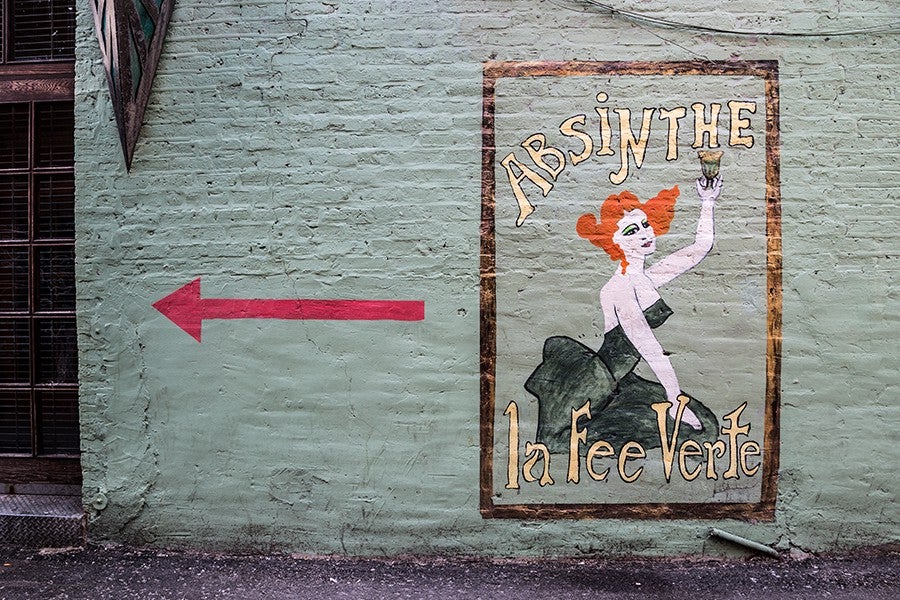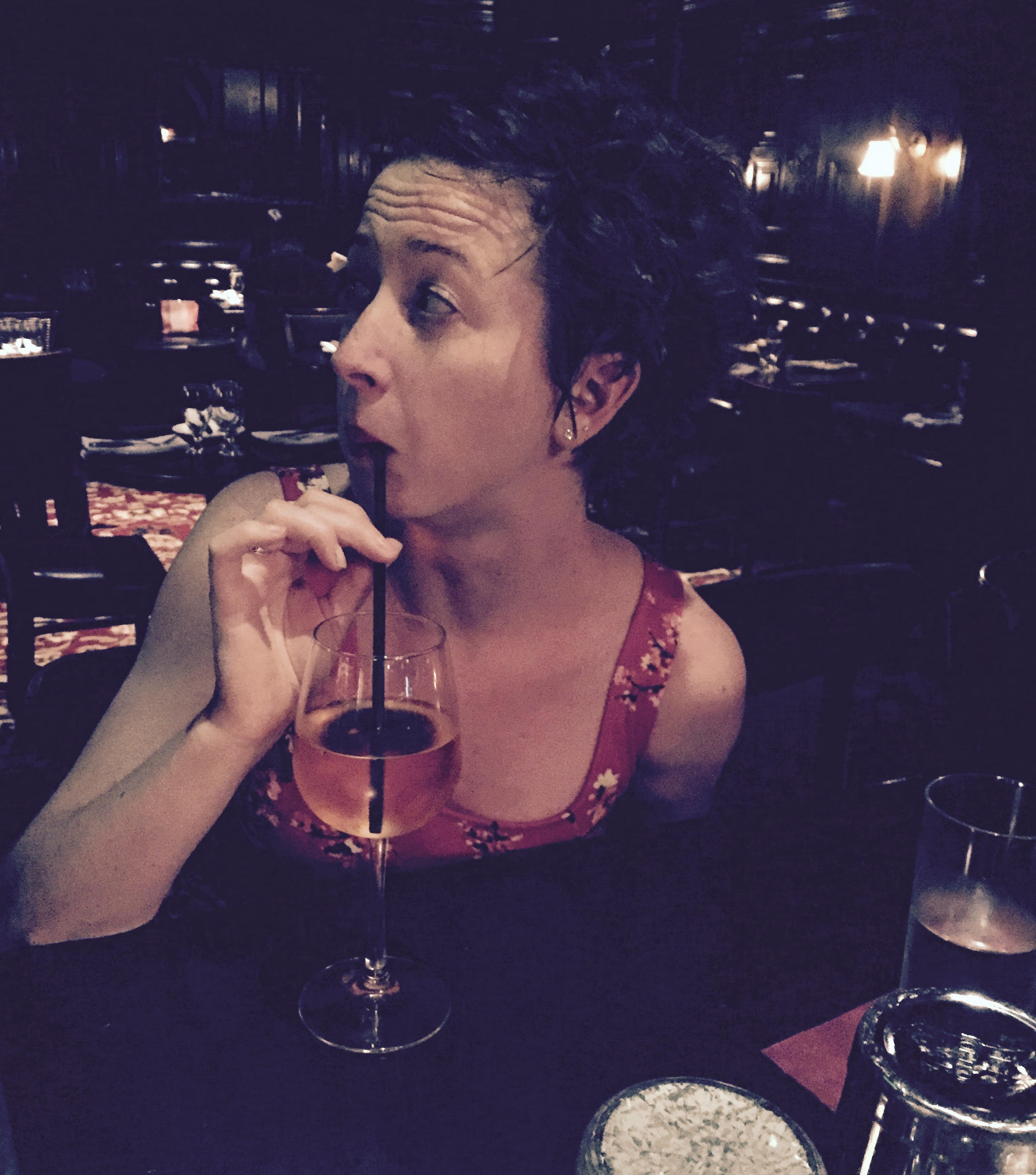Not that long ago, this guy walks into my bar. He gets a beer, fiddles with his beard and stares at the bottles lining the shelves behind me. Eventually, he smirks, flags me down and tells me that our bottle of Lucid, the first American absinthe made in the traditional 19th century French style in nearly a century, isn’t “real absinthe.” He’s had “real absinthe,” he assures me, and it made him “trip so hard, man.”
“Absinthe won’t make you hallucinate,” I respond. “It actually never has.”
“American absinthe won’t,” he shoots back. “But the real stuff in Europe will.”
“The modern production methods aren’t any different. This,” I explain, gesturing to the sleek black bottle with electric green cat eyes standing behind me, “is made the same way as what they make in Europe.”
“No, it’s not,” he offers in return. “There’s no thujone in American absinthe.”
Thujone is a chemical, a poison really, contained in wormwood, one of the key botanicals in absinthe. It’s transferred to the base alcohol of absinthe (a neutral grain spirit) during distillation. In high doses, like lethal doses, thujone can cause fevers, seizures, and yes, delirium. But it can’t — seriously, truly — make you have visions.
Nonetheless, my guy doubles down: “I drank absinthe in Europe, and I tripped face.”
“Did you drink the whole bottle?”
“Yeah, I did, man.”
“No wonder you think you saw things: That shit’s 130 proof. It’s a miracle you didn’t go blind,” I say, walking away, leaving him to his High Life.
The guy was wrong. But he isn’t alone. Most people — especially most people in the U.S. — get absinthe wrong, essentially parroting an urban legend: Absinthe will make you hallucinate, drive you crazy, and if you’re lucky, ignite a spark of creative genius somewhere along the way.
But that’s all bullshit. Very romantic, very endearing, very nostalgic bullshit, but bullshit all the same.
Absinthe was banned in the U.S. in 1912, but only after a major crackdown on the green drink’s production and consumption in Europe. (Switzerland banned absinthe in 1906; Holland in 1910; and France in 1914.) By that point, the spirit had become the West’s scapegoat for all manner of social ills (addiction, promiscuity, poverty, homosexuality and outspoken women to name a few).
Remember “Reefer Madness”?
Take that hysteria, travel back to late 19th century France and apply it to an alcohol popular among writers, painters and the poor — many of whom were self-medicating in pursuit of escape, entertainment and/or enlightenment — and you’ll get everything the government wanted you to think about absinthe.
But here’s what really went down.

Modern absinthe was most likely born in 1792, fathered by the French doctor Pierre Ordinaire who had fled the French Revolution and settled in Switzerland. His 136-proof elixir, which was comprised of wormwood, anise, hyssop, sweet flag, dittany and Melissa, as well as coriander, camomile, parsley and occasionally spinach, was a popular local cure-all and earned the nickname La Fée Vert (or The Green Fairy).
By way of purchase, marriage and possibly theft, Ordinaire’s recipe was, by 1797, being produced en masse and sold as recreational alcohol in a distillery owned by Henri-Louis Pernod, still one of the most widely recognized names in absinthe today. But it picked up real momentum in the 1840s, when French soldiers were sent off to Africa — France was now at war with Algeria — with bottles of absinthe to stave off malaria (and boredom). When the war ended in 1847, thousands of young Parisians poured back into the city with an acquired taste for high octane, anise-y booze.
Roughly 25 years later, opium and morphine had made their way into mainstream French culture, too. (The same for ether and cocaine.) As these things do, drugs were widely used and wildly popular in artistic circles and other countercultural communities (for the time): “Addiction, homosexuality and transvestism did not necessarily go together,” Eugene Weber writes in France: Fin de Siècle, “but they moved in the same circles and were part of the same fin de siècle spirit.”
If anyone can be credited with bringing absinthe to the Parisian literary community, it’s poet Paul Verlaine. A close second was his lover, another poet, Arthur Rimbaud. Rimbaud arrived in Paris in 1871, and was immediately drawn to Verlaine, a fairly famous writer but a legendary drunk. “The poet makes himself a seer through a long, prodigious and rational disordering of all the senses,” Rimbaud once wrote. He, in short, believed that indulging in his vices was the path to becoming a visionary. Along the way, however, he managed to drink himself into a knife-wielding frenzy and slash Verlaine across the arms, and later, in the thigh. Overall, he was absolutely vile. For example, he kept lice in his hair to throw at people, and he attended public readings for the sole purpose of screaming obscenities at whomever was on stage.
For his part, Verlaine would get so drunk that he’d violently beat his wife (often while Rimbaud cheered him on). Later, when Rimbaud ended their relationship, Verlaine shot him; he missed, mostly. Still, Verlaine was sentenced to five years in prison.
All of this horrified the French government. So much so that in 1906, a decade after Verlaine died, destitute, in a hospital bed, the French Ligue National Contra L’Alcoolism (roughly translated as the National League Against Alcohol) collected 400,000 signatures on a petition that declared:
Absinthe makes one crazy and criminal, provokes epilepsy and tuberculosis, and has killed thousands of French people. It makes a ferocious beast of man, a martyr of women and a degenerate of the infant, it disorganizes and ruins the family and menaces the future of the country.
The same type of story was being spun in nearby Switzerland:
Jean Lanfray got up early, as he always did, on August 28, [1906] and, as he always did, poured himself a shot of absinthe with a bit of water. He had a second absinthe with breakfast.
At 5:30 a.m. Lanfray stopped at a local cafe on his way to work and had a creme de menthe and then a cognac and soda.
There were six glasses of wine at lunch. At 4:15 p.m. he had one more glass of wine. 4:30 was coffee and brandy. That night, he and his father each had a liter of wine, and shortly thereafter, Lanfray shot and killed his wife and two-year-old daughter.
The story of the “absinthe murder” made international headlines — no matter the fact that Lanfray also had creme de menthe, cognac, brandy and copious amounts of wine in his system when he committed the crime.
Despite the ban, absinthe was so ingrained in French culture that, in 1922, a wormwood-free version of the booze was legalized. (By then, everyone was convinced it was the traces of thujone that was causing all the drama.) A decade later, a wormwood-less American variation, Herbsaint, appeared in New Orleans, the absinthe capital of the U.S. But between 1914 and 2011 in France, and 1912 and 2007 in the U.S., no absinthe with wormwood (so, really, no true absinthe) was produced or imported in either country.
And so, all of the legends of absinthe then became about wormwood and thujone. In fact, when wormwood was allowed back into the spirit in the U.S. in 2007, many were under the impression that the FDA-approved levels of thujone (10 parts per million, or about 10 mg/kg) were way below what the pre-Prohibition European-distilled spirit contained — allegedly an astonishing 260 parts per millions.
Yet in 2002, Ian Hutton, a British antiques dealer and absinthe enthusiast, ran a molecular analysis of Vintage Pernod Fils and found that the pre-Prohibition elixir contained just 6 mg/kg of thujone. In other words, less than the FDA-approved contemporary version. And while it’s true that the amount of thujone allowed in European absinthe today is 35 mg/kg, it’s still nowhere near the fictional levels of yore.
Not to mention, the amount of thujone is truly irrelevant. Thujone isn’t a drug. Case in point: When I contact Brad Burge at the Multidisciplinary Association for Psychedelic Studies, an organization dedicated to researching psychedelic drugs and their potential benefits, to discuss whether thujone ought to be considered a hallucinogen, he didn’t know where to start.
He had to Google “thujone” to find out what I was talking about.

Every time someone sits down at my bar and notices the ornate, green bottles lining the top shelf, they always ask, “So, is that real absinthe?”
Strangely, though, they don’t order it all that often. And the ones who do are generally bros looking to get lit quick. After all, even if everything else they “know” about absinthe is wrong, it’s still always one of the booziest bottles at the bar.
Every now and again, though, someone will catch sight of the bottle and say, “Absinthe — so, uh, what do you make with that?”
Ordering absinthe straight, with a side of water, would be the most traditional way to drink it, but for a lot of people, the combination of high proof and super zesty anise flavor can be off-putting. Also: Sugar cubes and fountains, while pretty, are unnecessary, and lighting an absinthe-covered sugarcube on fire over your glass is mainly just going to drip burned sugar into your drink.
There are, though, a handful of classic cocktails that require absinthe. A sazerac, for example, uses only a touch of it but is impossible to make otherwise. Similarly, Death in the Afternoon, a drink Hemingway claims he invented, is a Prohibition-era cocktail named after his nonfiction book on Spanish bullfighting by the same name that consists of absinthe and sugar topped with sparkling wine. (Spain is the only country in the EU that didn’t, at some point, outlaw absinthe.)
My personal favorite absinthe cocktail, however, is the Corpse Reviver #2: Equal parts gin, lemon juice, Cocchi Americano and orange liqueur with a spritze of absinthe rinsing the glass it is a tart, dry, licorice-y masterpiece. (It’s also well-known for helping with hangovers.)
Another absinthe pro-tip: Check the ingredients before you buy a bottle. Anything that has FD&C Yellow 5 (or FD&C anything, really) should be avoided. These are the types of alcohol that are basically vodka infused with wormwood and herbs and then dyed to make it green. And while Pernod will always be a classic, it, too, has some less-than-stellar bottles on the market — largely to hit that price-point sweet spot of $20 to $30. The good stuff — e.g., Pernod Absinthe Superiure — will run you about $75 a bottle. (As a rule, absinthe is generally expensive.)
When out at the bar, ask your bartender what they pour. All cocktail bars ought to stock at least one brand, and most carry two or three. (Again, check the bottle for added dyes.)
However you decide to drink it, just remember: You won’t be tripping balls afterward. And neither was Verlaine and Rimbaud (at least on absinthe alone).
You will most likely end up drunk off your ass, though.

